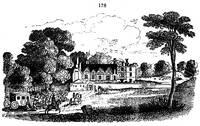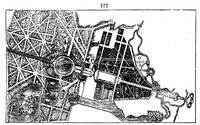566. Evelyn in 1662 mentions the following gardens, as having been visited by him in that year: - Wanstead House, Essex (fig. 177.): 'I went to see Sir Josiah Child's prodigious cost in planting walnut-trees about his seat, and making fishponds some miles in circuit in Epping Forest in a barren spot, as oftentimes these suddenly monied men for the most part seat themselves.' In 1822 this magnificent seat was reduced to a mere mass of materials, through the improvidence of Wellesley Long Pole Long Wellesley, who became possessed of it by marriage. The house was sold in lots, and the ground let in small portions on building leases. - A citizen's garden: 'One Loader, an anchorsmith in Greenwich, grew so rich, as to build a house in the street, with gardens, orangeries, canals, and other magnificence, on a lease. His father was of the same trade, and an anabaptist.'-Bushnell's Wells at Enstone: 'This Bushnell had been secretary to Lord Verulam. It is an extraordinary solitude. There he had two mummies, and a grot, where he lay in a hammock like an Indian. Hence we went to Ditchley, an ancient seat of the Lees,' &c. Bushnell's gardens and waterworks still exist, and are shown as curiosities to strangers. - Ham House, and garden of the Duke of Lauderdale, Middlesex: 'Inferior to few of the best villas of Italy itself, the house furnished like a great prince's; the parterres, flower-gardens, orangeries, groves, avenues, courts, statues, perspectives, fountains, aviaries, and all this at the banks of the sweetest river in the world, must needs be admirable.' Sir Henry Capel's orangery and myrtetum at Kew, 'most beautiful and perfectly well kept. He was contriving very high palisadoes of reeds to shade his oranges during the summer, and painting these reeds in oil.' Althorp, Lord Spencer's, Northamptonshire. 'The iron gate opening into the park of very good work, wrought in flowers, painted in blue, and gilded.' Beddington, the seat of the Carews, Surrey, now decaying, 'heretofore adorned with ample gardens, and the first orange trees that had been seen in England, planted in the open ground, and secured in winter only by a tabernacle of boards and stoves, &c. standing a hundred and twenty years. Large and goodly trees, and laden with fruit, now in decay, as well as the grotto and fountains; the cabinets and other curiosities in the house and abroad being now fallen to a child under age, and only kept by a servant or two from further dilapidation. The estate and park about it also in decay.' Aubrey says the orange trees mentioned by Evelyn were planted by Sir Francis Carew at Beddington, and were brought by him from Italy; but the editors of the Biogr. Britan., edit. 1748, art. Raleigh, speaking from a tradition preserved in the family, say they were raised by Sir Francis Carew from the seeds of the first oranges which were imported into England by Sir Walter Raleigh, who had married his niece, the daughter of Sir Nicholas Throckmorton. See an account of this garden in 1691, in Archï¾µologia, vol. xii. The orange trees at Beddington were destroyed by the hard frost in 1739-40. Queen Elizabeth visited Sir F. Carew in Aug. 1599; and Sir Hugh Plat, in his Garden of Eden, relates a curious anecdote of his keeping back the ripening of a cherry tree, for one of her visits. Marden, Surrey. 'Originally a barren warren, bought by Sir Robert Clayton, who built there a pretty house, and made such alteration by planting, not only an infinite store of the best fruit, but so changed the natural situation of the hills, valleys, and solitary mountains about it, that it rather represented some foreign country which could produce spontaneously pines, firs, cypress, yew, holly, and juniper: they were come to their perfect growth, with walks, &c. among them.' Alburie Howards, Surrey. 'Found the garden exactly done to the design and plot I had made, with the crypt through the mountain in the park, 30 perches in length. Such a Pausilippe (alluding to the grot of Pausilippo at Naples) is nowhere in England besides. The canal was now digging, and the vineyard planted.'-We visited Albury in 1831, and found a part of the crypt still remaining, though stopped up at the farther end; A view of Albury is given in Aubrey's Surrey (fig. 178.), as it existed in Evelyn's time. A new house has been since built, and the gardens have been entirely altered. (See Gard. Mag., vol. vii. p. 364.) Swallowfield, Lady Clarendon, Berkshire. 'Lady C. skilled in the flowery part, my lord in diligence of planting. Water flagged with calamus, all that can render a country-seat delightful, and a well-furnished library in the house.' (Mem. by Bray, i. 432.)



